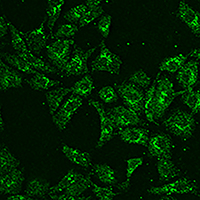Ciliary neurotrophic factor (CNTF) and its receptor (CNTFRα) signal through MAPK/ERK pathway in human prostate tissues: a morphological and biomolecular study

Submitted: 4 June 2020
Accepted: 15 September 2020
Published: 19 October 2020
Accepted: 15 September 2020
Abstract Views: 875
PDF: 570
HTML: 13
HTML: 13
Publisher's note
All claims expressed in this article are solely those of the authors and do not necessarily represent those of their affiliated organizations, or those of the publisher, the editors and the reviewers. Any product that may be evaluated in this article or claim that may be made by its manufacturer is not guaranteed or endorsed by the publisher.
All claims expressed in this article are solely those of the authors and do not necessarily represent those of their affiliated organizations, or those of the publisher, the editors and the reviewers. Any product that may be evaluated in this article or claim that may be made by its manufacturer is not guaranteed or endorsed by the publisher.
Similar Articles
- Valentina Alda Carozzi, Chiara Salio, Virginia Rodriguez-Menendez, Elisa Ciglieri, Francesco Ferrini, 2D vs 3D morphological analysis of dorsal root ganglia in health and painful neuropathy , European Journal of Histochemistry: Vol. 65 No. s1 (2021): Special Collection on Advances in Neuromorphology in Health and Disease
- Hui Yang, Yunlong Zhang, Desheng Zhang, Liping Qian, Tianxing Yang, Xiaocheng Wu, Crocin exerts anti-tumor effect in colon cancer cells via repressing the JAK pathway , European Journal of Histochemistry: Vol. 67 No. 3 (2023)
- Y. Zhang, W.Y. Ye, J.Q. Wang, S.J. Wang, P. Ji, G.Y. Zhou, G.P. Zhao, H.L. Ge, Y. Wang, dCTP pyrophosphohydrase exhibits nucleic accumulation in multiple carcinomas , European Journal of Histochemistry: Vol. 57 No. 3 (2013)
- Minkai Cao, Deping Yuan, Hongxiu Jiang, Guanlun Zhou, Chao Chen, Guorong Han, Long non-coding RNA WAC antisense RNA 1 mediates hepatitis B virus replication in vitro by reinforcing miR-192-5p/ATG7-induced autophagy , European Journal of Histochemistry: Vol. 66 No. 3 (2022)
- Wanchun Wang, Jun Yi, Degang Dong, Wenli Mao, Xuanyu Wang, Zhangren Yan, miRNA-877-5p inhibits malignant progression of prostate cancer by directly targeting SSFA2 , European Journal of Histochemistry: Vol. 65 No. 3 (2021)
- A. Demirovic, S. Cesarec, Z. Marusic, D. Tomas, M. Milosevic, T. Hudolin, B. Kruslin, TGF-β1 expression in chromophobe renal cell carcinoma and renal oncocytoma , European Journal of Histochemistry: Vol. 58 No. 1 (2014)
- G. Musumeci, C. Loreto, M.L. Carnazza, F. Coppolino, V. Cardile, R. Leonardi, Lubricin is expressed in chondrocytes derived from osteoarthritic cartilage encapsulated in poly(ethylene glycol) diacrylate scaffold , European Journal of Histochemistry: Vol. 55 No. 3 (2011)
- I. Kopera, M. Durlej, A. Hejmej, K. Knapczyk-Stwora, M. Duda, M. Slomczynska, M. Koziorowski, B. Bilinska, Effects of pre- and postnatal exposure to flutamide on connexin 43 expression in testes and ovaries of prepubertal pigs , European Journal of Histochemistry: Vol. 54 No. 2 (2010)
- A.R.M. Sabbatini, L. Mattii, B. Battolla, E. Polizzi, D. Martini, M. Ranieri-Raggi, A.J.G. Moir, A. Raggi, Evidence that muscle cells do not express the histidine-rich glycoprotein associated with AMP deaminase but can internalise the plasma protein , European Journal of Histochemistry: Vol. 55 No. 1 (2011)
- H. Xu, X. Zhang, H. Wang, Y. Zhang, Y. Shi, X. Zhang, Continuous cyclic mechanical tension increases ank expression in endplate chondrocytes through the TGF-β1 and p38 pathway , European Journal of Histochemistry: Vol. 57 No. 3 (2013)
<< < 5 6 7 8 9 10 11 12 13 14 > >>
You may also start an advanced similarity search for this article.

 https://doi.org/10.4081/ejh.2020.3147
https://doi.org/10.4081/ejh.2020.3147










